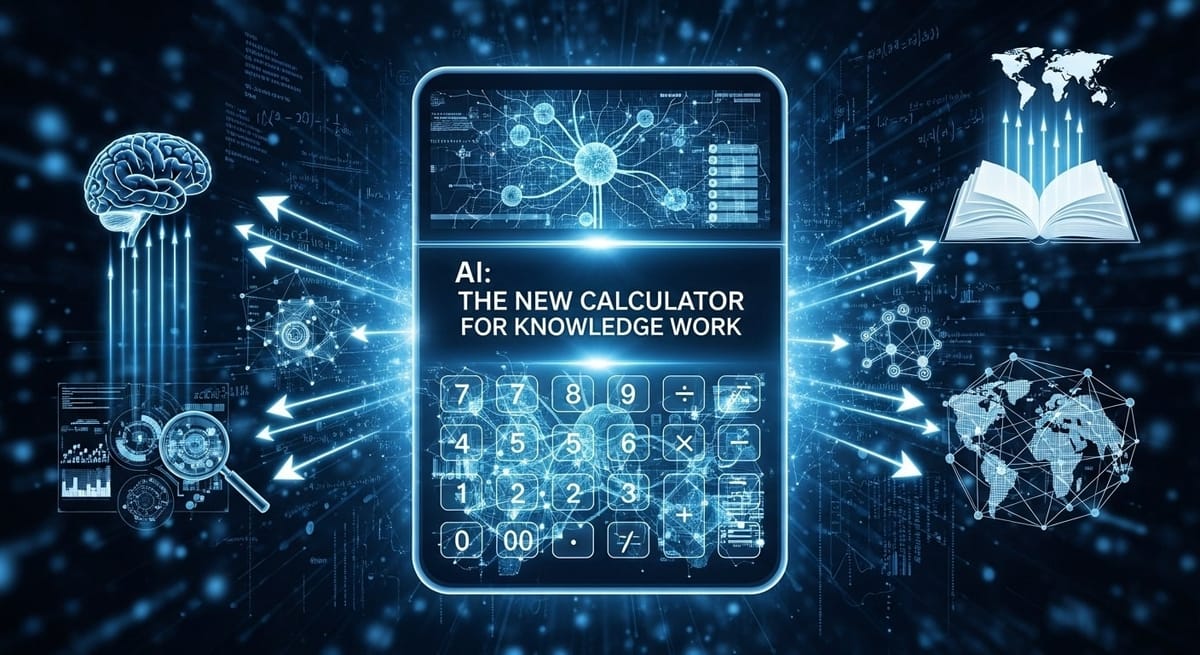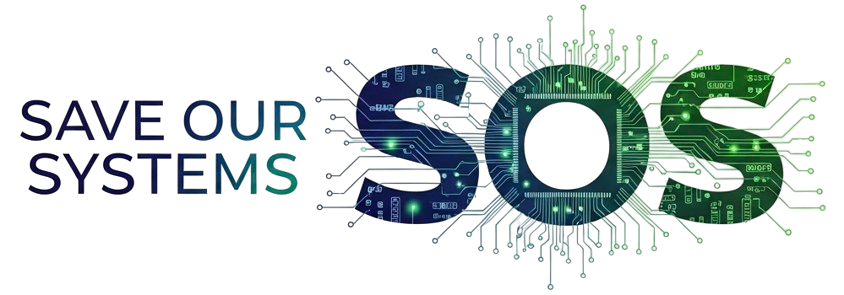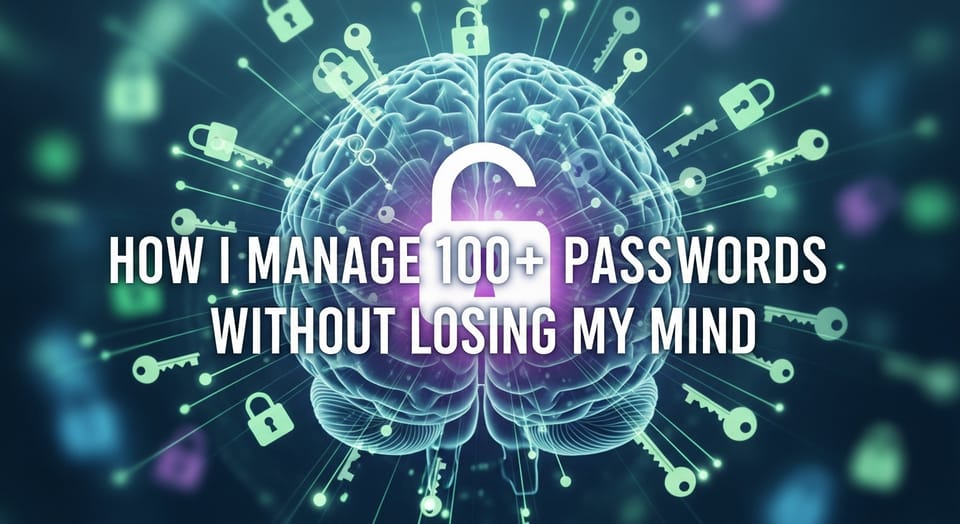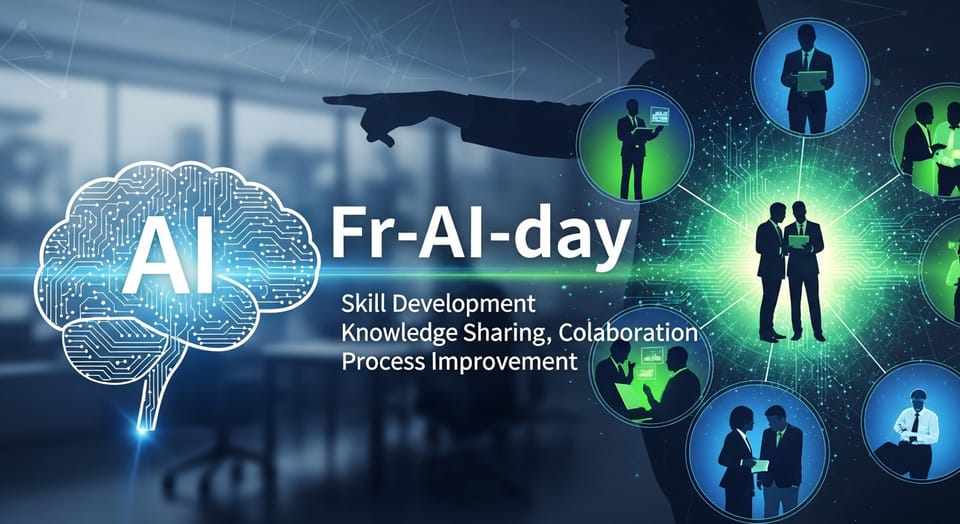AI: The New Calculator for Knowledge Work

In the 1970s, a revolutionary tool transformed mathematics education and professional work forever: the electronic calculator. By automating complex computations, calculators freed human minds to focus on higher-level mathematical thinking rather than mechanical calculation. Today, we're witnessing a similar revolution in knowledge work with the emergence of artificial intelligence as a cognitive extension for human thought and creativity.
The Super Calculator of Knowledge and Language
Generative AI and large language models (LLMs) are emerging as "super calculators" for human knowledge and language. Just as calculators automated complex mathematical operations, these AI systems automate aspects of language processing and knowledge synthesis. Research from Stanford's Human-Centered AI Institute supports this view, describing large language models as "knowledge processing systems that combine retrieval-like and reasoning-like behaviors."
The parallel works on several levels:
- Both technologies extend human cognitive capabilities rather than replacing them
- They transform time-consuming tasks into near-instantaneous operations
- They democratize access to capabilities that previously required specialized training
The key distinction lies in their domains: calculators process numbers, while AI processes language and knowledge representations.
The Evolution of Computational Tools
The historical progression illustrates this evolution clearly:
- 1960s-1970s: Electronic calculators transformed mathematics education
- 1990s-2000s: Search engines became "knowledge calculators"
- 2010s-present: Generative AI emerges as language and knowledge calculators
Each innovation built upon previous technologies while expanding human capability in new directions.
Bridging Ideas and Expression
For many users, AI's most transformative aspect is its ability to accelerate writing and creativity. Having "great ideas and thought" doesn't always translate to "well-polished articles or posts" without significant effort. AI bridges this gap by reducing the cognitive load associated with mechanical aspects of writing, assisting with structural organization, suggesting alternative phrasings, and generating draft content that humans can refine.
Stanford researchers have documented these benefits, finding that AI writing assistants help writers overcome initial barriers to production and refine ideas more efficiently. This capability is particularly valuable for individuals with strong ideas but limited time or specialized writing skills—much like calculators help those who understand mathematical concepts but struggle with computation.
Templated Approaches: The Formula for Consistent Results
The use of templated prompts with AI systems further reinforces the calculator analogy. Just as spreadsheet users create formulas to ensure consistent calculations, prompt templates ensure consistent AI outputs. Research from OpenAI has shown that structured prompting significantly improves the reliability of LLM outputs, leading to the emergence of "prompt engineering" as a specialized skill.
Examples of templated approaches include:
- Chain-of-thought prompting for complex reasoning tasks
- Few-shot learning through demonstration examples
- Role-based prompting to elicit specific perspectives
AI vs. Traditional Calculators: Similarities and Differences
While the calculator analogy is helpful, important distinctions exist between traditional calculators and AI systems:
| Aspect | Traditional Calculator | Generative AI |
|---|---|---|
| Input/Output Type | Numerical inputs, deterministic outputs | Language inputs, probabilistic outputs |
| Transparency | Algorithm-based, predictable | Neural network-based, less transparent |
| Domain Coverage | Mathematical operations only | Language, knowledge, reasoning, creativity |
| Error Patterns | Typically user input errors | Hallucinations, bias, contextual misunderstandings |
Researchers at MIT have explored these distinctions, noting that "calculators perform deterministic computations on well-defined inputs, while LLMs generate probabilistic outputs based on complex patterns learned from vast datasets" (Karpathy, 2023).
AI: A Compressed Internet in Your Pocket
Modern LLMs like GPT-4 are trained on vast portions of the internet and other text sources, effectively internalizing much of human knowledge in their parameters. Unlike search engines that retrieve information, LLMs:
- Generate rather than retrieve information
- Have knowledge cutoffs based on training data
- Lack the ability to verify information against current sources
Recent research from Berkeley AI Research suggests that LLMs are best understood as "compressed models of the internet and books" rather than as search engines (Wieschollek et al., 2023). This compressed knowledge allows them to function as knowledge calculators without direct internet access during inference.
The Future of Cognitive Tools
Just as calculators didn't eliminate the need for mathematical understanding but rather transformed how we apply it, AI doesn't replace human creativity and knowledge but amplifies our ability to express and develop ideas. For writers, thinkers, and creators, AI serves as a powerful tool that bridges the gap between raw thoughts and refined expression.
As we continue to integrate AI into our cognitive workflows, understanding its role as a "super calculator" of human knowledge helps set appropriate expectations and optimize its use. Like the calculator before it, AI may fundamentally change how we approach certain tasks without diminishing the value of human insight, creativity, and critical thinking that gives those tasks meaning.
Sources
Bender, E. M., Gebru, T., McMillan-Major, A., & Shmitchell, S. (2021). On the Dangers of Stochastic Parrots: Can Language Models Be Too Big? FAccT '21.
Bommasani, R., Hudson, D. A., Adeli, E., Altman, R., Arora, S., von Arx, S., ... & Liang, P. (2021). On the opportunities and risks of foundation models. arXiv preprint arXiv:2108.07258.
Brown, T. B., Mann, B., Ryder, N., Subbiah, M., Kaplan, J., Dhariwal, P., ... & Amodei, D. (2020). Language models are few-shot learners. arXiv preprint arXiv:2005.14165.
Hancock, J. T., Naaman, M., & Levy, K. (2022). AI-Mediated Communication: How the Perception That Profile Text Was AI-Generated Affects Trust and Perception. Journal of Computer-Mediated Communication, 27(1).
Karpathy, A. (2023). State of GPT. Lecture at Microsoft Build.
Wieschollek, P., Fuchs, F. B., & Gharbi, M. (2023). Understanding Visual Features in Large Language Models. arXiv preprint arXiv:2303.08128.




